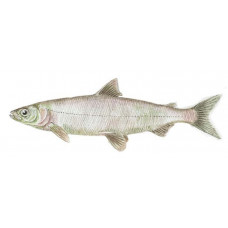Latin name
Coregonus spp
Other names
Gray back, tullibee, lake herring, whitefish.
Identification
Characterised by a thick dorsal fin and a split tail, the cisco has a terminal mouth (lower jaw slightly protruding from the upper jaw). The body is elongated and slender, with less than 100 scales along the lateral line. The pelvic axillary, or dagger, is well developed. The colouration is dark grey to bluish on the back, silvery on the sides and white underneath. All fins are relatively transparent, although the anal and pelvic fins can be milky in adults. As a group, cisco (and whitefish) are easily distinguished from other species by the presence of the adipose fin. Cisco can be distinguished from lake whitefish (Coregonus clupeaformis), which inhabit the same deeper waters, by their pointed snout, terminal mouth and lack of teeth. The mouth of the cisso is at the end of the head, while that of the whitefish is behind and below the snout. They differ from lake trout (Salvelinus namaycush) in that they have larger scales, a larger mouth and no teeth.
Distribution
Ciscos are primarily native to Canada, where they are distributed roughly east of the Mackenzie River through Ontario and north through the Northwest Territories and much of Quebec. They inhabit the Great Lakes and their tributaries (including the St Lawrence River). Found in some lakes in states bordering the Great Lakes, including the Finger Lakes in New York, and in the headwaters of the Mississippi River.
Habitat
Cold water lakes are preferred habitats for cisco. They may be near the surface when the water is cold, or a few hundred metres deep, but they usually remain below the thermocline in stratified lakes. They tend to accumulate in the middle layers of water and move to shallower areas as the water cools in autumn. Water temperatures above 60°F are lethal to cisco, so as surface water warms, these fish move to deeper water. In winter, many swim close to the surface, providing ice fishing opportunities.
Size
Cisco can range in length from 6 to 25 inches, with an average size of 10 to 14 inches and 1⁄2 lb. The world all-tackle record belongs to the Manitoba fish (C. artedii), which weighed 7 lb 6 oz. The average life expectancy is 8 years. In some lakes the cisco population can be sparse and most fish are small.
Life history and Behavior
Cisco is a schooling fish that spawns in large aggregations in late autumn after moving to shallow waters 3 to 10 feet deep, often on reefs, when water temperatures are around 39-41°F. Females can lay up to 30,000 eggs on the lake bottom, usually on gravel or rocks. The eggs require no parental care and hatch within 4 months. Almost all cissos reach maturity by the fourth season. Some, such as the small cisco (C. sardinella), are anadromous but do not migrate far from the estuary.
Food and feeding habits
The main food source for cisco is plankton. In early spring, when they are most active (and shallow) feeders, they may eat minnows, crustaceans and mayflies.
Reproduction
No information
| Classification | |
| Phylum | Chordata |
| Class | Actinopterygii |
| Squad | Salmoniformes |
| Family | Salmonidae |
| Genus | Coregonus |
| Features | |
| Conservation status | No information |
| Habitat | Pelagic |
| Life span, years | 8 |
| Maximum body weight, kg | 3.3 |
| Maximum length, cm | 63.5 |
| Sailing speed, m/s | No information |
| Threat to people | Edible |
| Way of eating | Predator |
Cisco
Tags: Cisco

